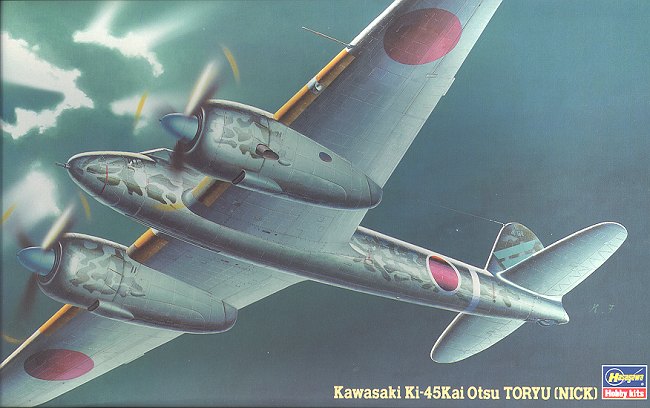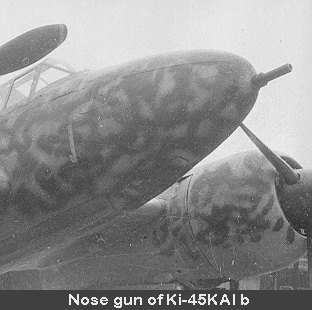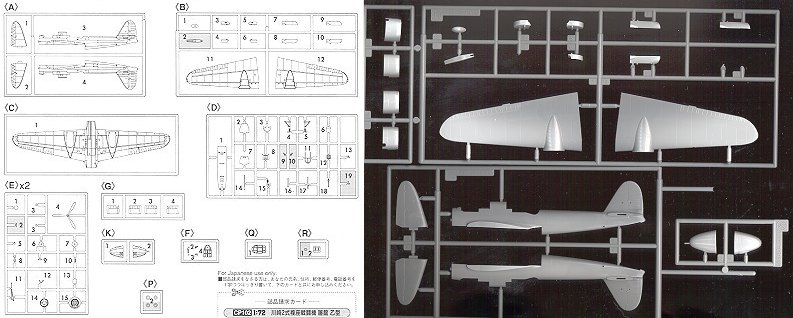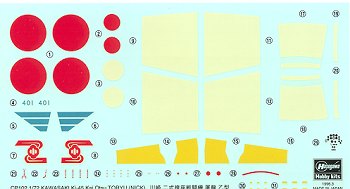
|
KIT: |
Hasegawa 1/72 Ki-45 kai Otsu 'Nick' |
|
KIT # |
51262 |
|
PRICE: |
$37.98 |
|
DECALS: |
See review |
|
REVIEW & |
|
|
NOTES: |
|

|
HISTORY |
The Ki-45 was Japan's answer to the heavy fighter like Germany's Bf-110. However, it was not used as a bomber escort, but mainly for ground attack, a role in which it was relatively successful. It was also used as a bomber interceptor and was armed with Schräge Muzik or obliquely mounted cannon in the aft cockpit.
 The Ki-45 had an extremely long gestation period before it finally
entered production. There were all sorts of problems much of them relating to
tail flutter and lack of general stability. There was also a lack of power from
the chosen engines. As this aircraft was also being developed concurrently with
the Ki-48 and using many of the same components, similar problems cropped up
with the Ki-48. Eventually the
airframe was modified and more powerful engines used bring the aircraft up to
specifications.
The Ki-45 had an extremely long gestation period before it finally
entered production. There were all sorts of problems much of them relating to
tail flutter and lack of general stability. There was also a lack of power from
the chosen engines. As this aircraft was also being developed concurrently with
the Ki-48 and using many of the same components, similar problems cropped up
with the Ki-48. Eventually the
airframe was modified and more powerful engines used bring the aircraft up to
specifications.
Most of the Ki-45s that entered service were the Ki-45KAI (KAI = modified) version. There were three subtypes of the Ki-45KAI; the a, b, and c versions. They are all differentiated by armament and nose shapes. The a has a relatively blunt nose with a landing light in it, The b has a 20mm cannon in it, and the c has a sharper nose. Both the a and c have two machine guns in the nose and the some versions of the c had the obliquely mounted cannon.
The subject of this kit, the Ki-45KAIb was specifically developed as a ground attack aircraft, hence the 20mm nose cannon in addition to the 37mm ventral cannon. This relatively heavy forward firepower made it perfect for hunting PT boats or intercepting 5th AF Liberators.
As for some specs, the top speed was 340 mph, range about 1,400 miles and a little over 1,700 aircraft were built. One was experimentally fitted with a 75mm cannon, but it proved too much for the light airframe of the Ki-45.
|
THE KIT |

The date on the box is 1996, so this is a pretty recent model for Hasegawa. Hasegawa started producing super 1/72 models of Japanese WW2 twin-engined aircraft around the middle of the '90s and they have made almost no impact on the modeling community here in the US. I'm not sure if it is the subjects of the kit or the scale or the price of them that has kept them out of sight, but in several years of attending model shows here around St. Louis, the only one I have seen on the tables has been the Ki-67 kit I entered at Memphis in 2000. And it is a shame as they are very nice kits.
I don't think I need to go into the usual diatribe on how nice this kit is molded or the color of the plastic as all modern Hasegawa kits are very well done. You can see a diagram of all the kit parts and a sample of the sprues in the image above. What I will mention is that like the Ki-67 kit, this one has some sink marks in the plastic. There are not many of them and they are on either thick pieces or opposite alignment pins and slots, but they shouldn't be there at all. At least not for a nearly $40 1/72 aircraft kit! There is no flash as experienced with the Ki-67 kit earlier reviewed.
The cockpit is complete with a decal for the pilot's instrument panel and no sidewall detail at all. There is a rudder hinge that I think most modelers will leave off until the very end or it will make it difficult to apply the tail camo and unit decal. The engine nacelles look as if they will be a bit of a challenge. Though most of it is integral with the upper and lower wing, the portions forward of the leading edge consist of a number of pieces instead of doing the front cowling as one piece.
There is only one option on this kit and that is the installation of a shell collector for the 37mm ventral cannon. Landing gear are well detailed and look fragile, however construction will bear out how well they hold up.
 Decals
provide markings for two Ki-45KAIb's. One from the 21st flight regiment and the
other from the 4th. The box art shows the one from the 21st. Both are in overall
grey with random green bits on the upper surfaces. The 21st bird is in a blocky
style of overpainting while the 4th aircraft is more of random squiggles. Either
way, it will be fun to paint!. The 4th aircraft has white 'bandages' for a home
defense unit and the yellow IFF leading edge markings are provided as decals.
Frankly, I would not use these as this sheet suffers from a typical problem of
Japanese kit decals: the white is ivory and the reds a bit too bright.
Decals
provide markings for two Ki-45KAIb's. One from the 21st flight regiment and the
other from the 4th. The box art shows the one from the 21st. Both are in overall
grey with random green bits on the upper surfaces. The 21st bird is in a blocky
style of overpainting while the 4th aircraft is more of random squiggles. Either
way, it will be fun to paint!. The 4th aircraft has white 'bandages' for a home
defense unit and the yellow IFF leading edge markings are provided as decals.
Frankly, I would not use these as this sheet suffers from a typical problem of
Japanese kit decals: the white is ivory and the reds a bit too bright.
Typical of Hasegawa kits, all the parts are in one bag which means that parts are easily ripped from sprues and others are scratched by the shifting of the plastic during transportation. I do wish that Hasegawa would spend a few more yen to put fewer sprues in each bag as the other kit makers do. Other than that, it looks like a super kit that should build very nicely!
|
REFERENCES |
Japanese Aircraft of the Pacific War, Rene J Francillon, 1979
Famous Aircraft of the World #21: Army Type 2 Two-Seat Fighter 'Toryu', March 1990
Review copy courtesy of me and my wallet!
If you would like your product reviewed fairly and quickly by a site that has over 900 visits a day, please contact me or see other details in the Note to Contributors.